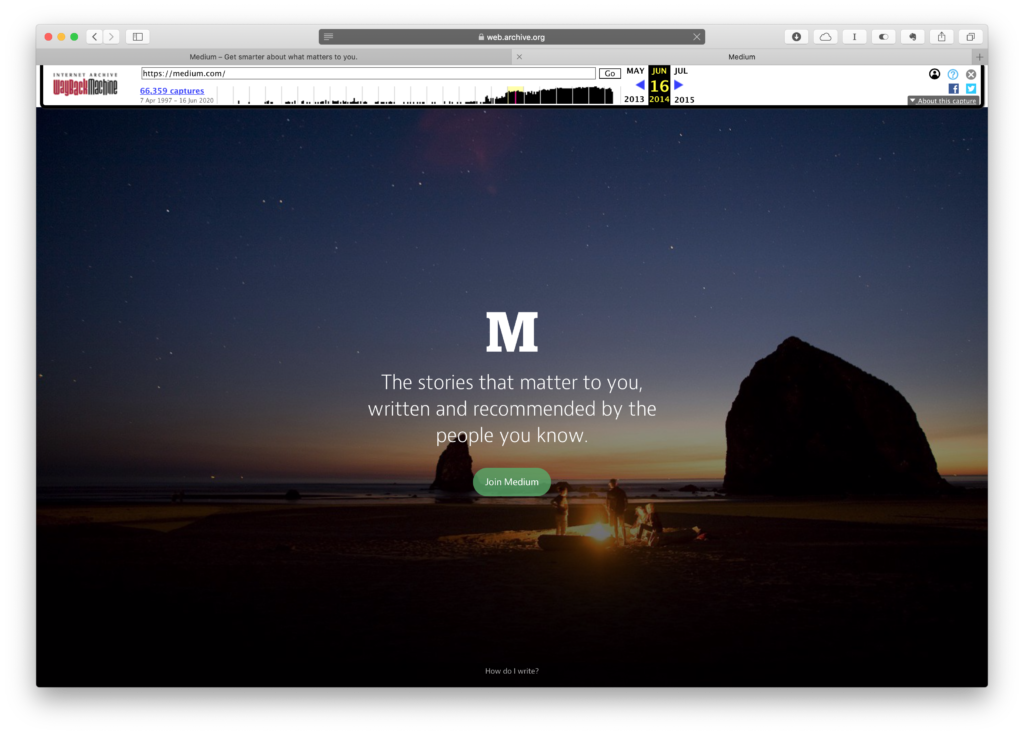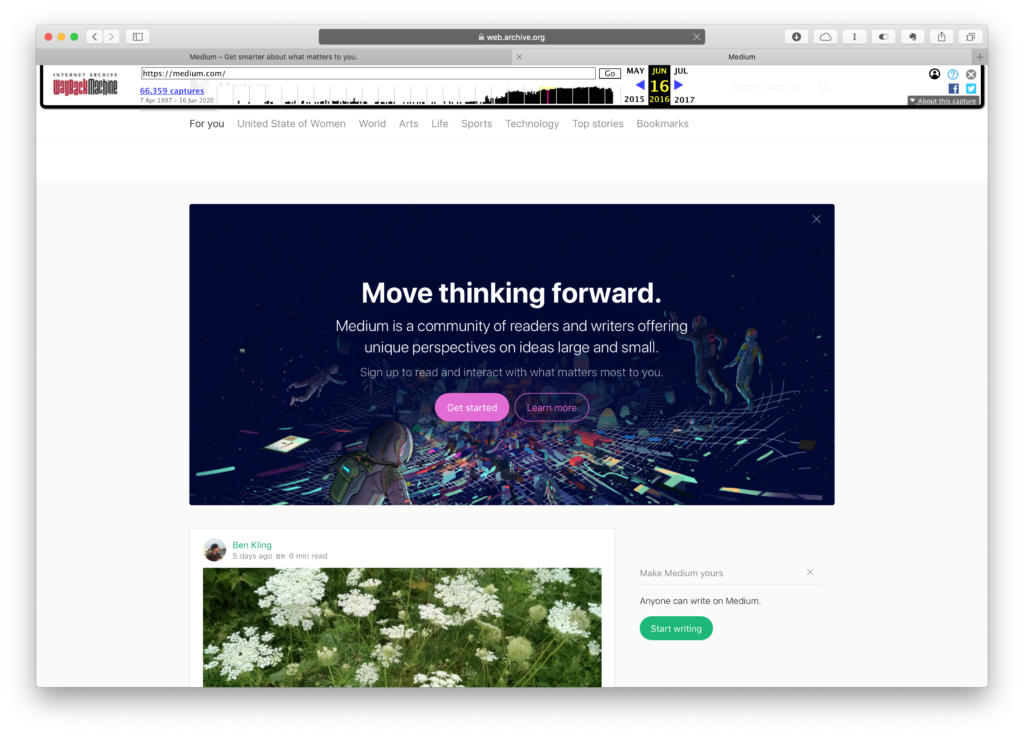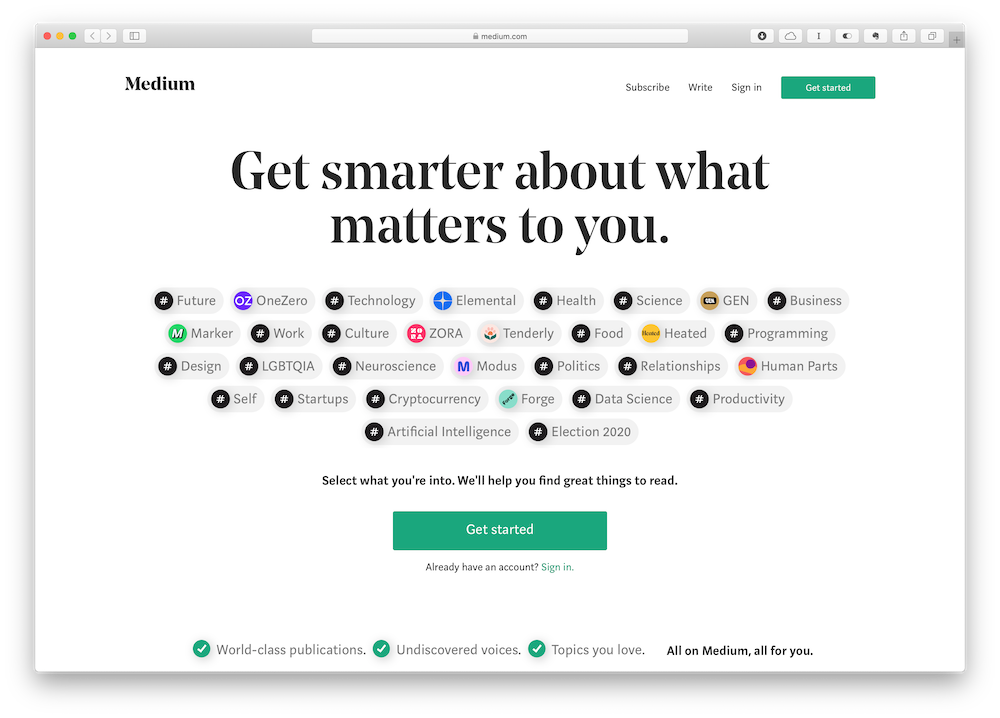(Part 1: RSS, Google Reader, Friendfeed, WordPress)
Medium, created by one of Twitter’s founders in 2012 “initially… as a way to publish writings and documents longer than Twitter’s 140-character[s]“, is built around both discovery and publishing. In its early days it appealed to both sides:


But having now establised itself as an attractive destination for writers, its home page focuses entirely on discovery. Each of the tags points to a Medium collective blog:

As an aside, Medium’s monetization model is somewhat contrived, based on a metric named Member Reading Time,
As a user reads, we measure their scrolls and take care to differentiate between short pauses (like lingering over a particularly great passage) and longer breaks (like stepping away to grab a cup of coffee). Reading time incorporates signal from your readers without hurdles. You don’t need to ask your readers to remember to clap, or click, or do anything other than read.
It is a bold take, but does not inspire confidence.
This is in contrast to Substack, which allows its publishers to set their own prices and takes a 10% cut plus Stripe’s card processing fees.
Which brings us full circle to Substack’s discovery. Unlike WordPress, Substack’s incentives are in fact aligned with its publishers build a paying audience. But so far it’s followed a WordPress-like publisher-centric positioning. As with most marketplaces, it’s starting with building supply.
This will likely change over time if and when Substack feels confident it has cemented its position as the dominant independent publishing platform.
The big unsolved problem and opportunity is yet a neutral discovery destination of great writing for your specific niche interests, whether that writing is on Substack or Medium or a WordPress hosted or self-hosted blog, or a Threader-collated Twitter thread.
(ends)

4 replies on “Discovery of independent publishers online – Part 2”
Hi Rahul. I think content discovery will be seamless when there are
a) no paywalls, and
b) a feeding mechanism leading to discovery, leading to feeds, leading to discovery…….a feedback loop.
Now Medium relies on paywalls, whereas the outmoded RSS mechanism can feed only content which one has chosen to follow. Its impossible for someone to discover content using RSS.
Thus, I think platforms like Quora and Patreon will find greater success than Medium and Substack.
Quora doesn’t have paywalls. Though primarily a very interesting Q&A site, users can also blog there, and have its ML system spread that content to users who’ve shown interest in it. I’ve seen how my interests result in more and more interesting content come to me by way of my own feed.
Patreon relies on users pulling content, rather than creators pushing (and marketing) content. For example, if some content interests you, you pay the creator, and get more of it. Though a paywall, this “content vetting” actually comes from sites like Quora itself (many creators advertise their Patreon pages there).
Finally, Quora lends itself to the larger indexing from Google, which Medium shuts itself from. It compliments Wikipedia that way. So, the chain of content consumption goes thus : Google’s indexing –> Quora’s discovery via feedback –> Patreon’s paid content.
I think we’re talking about two different things: I’m talking about discovery of independent publishers. This is regardless of whether they put all or part of their content behind paywalls or not. You’re talking about discovery of content from these publishers. This becomes difficult when the content is either explicitly excluded from Google and/or paywalled.
PS: I see Medium in search results all the time.
PPS: I am glad you have had a good experience on Quora. I gave it a lot of time but it’s my experience is a cesspool of irrelevance.
But, isn’t discovery of content the prerequisite to the discovery of creators ?
Not necessarily, although being able to preview content certainly helps.
There are several well-regarded people who run paid-only newsletters on Substack. See Tiago Forte’s “Praxis” newsletter. If Substack – or some third party discovery service for Substack – were to surface them and what they’re writing about, that becomes an example of discovery without content.
Today there doesn’t exist any such search/browse/recommend based discovery mechanism for good content on Substack. Maybe you heard about Praxis from this comment. Maybe you came across it on Twitter or such. It’s utterly serendipitous.